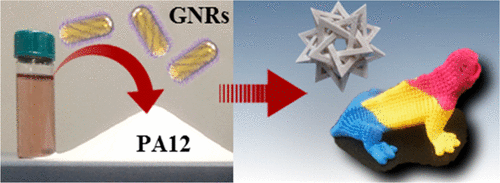3D printed parts can be dyed or painted, but dark gray or black objects are much harder to color than white or lighter-colored ones. Therefore, a group of researchers decided to find out of photothermal sensitizers could be developed that would produce white or colored parts. They presented their research in a paper entitled “White and Brightly Colored 3D Printing Based on Resonant Photothermal Sensitizers,” which you can access here.
“The use of photothermal sensitizers to facilitate the sintering of polymer powders is rapidly becoming a pivotal additive manufacturing technology, impacting multiple sectors of industry,” the researchers state. “However, conventional carbon-based sensitizers can only produce black or gray objects. To create white or colorful prints with this method, visibly transparent equivalents are needed. Here, we address this problem by designing resonant photothermal sensitizers made of plasmonic nanoparticles that strongly absorb in the near-infrared, while only minimally interacting with visible light.”
To create stable colorful nanocomposite powders, gold nanorods were coated with silica before being mixed with polyamide powders. At resonance, according to the researchers, the composites showed greatly improved light-to-heat conversion compared with equivalent composites using the industry standard carbon black as a synthesizer. The composites could also be sintered using low-power light sources. The resulting powders and 3D prints made from the powders appeared bright white and could produce colorful objects when mixed with dyes.
“Our results open a new route to utilize plasmonic nanoparticles to produce colorful and functional 3D-printed objects,” the researchers explain.
The recently published study is encouraging for those who want to pursue applications in which color is a necessary element. Even the best dyes have trouble turning black objects into brightly colored ones, and it’s especially difficult to get white objects from black or gray. There’s a reason that white is such a popular color choice for FDM filament; it can easily be dyed or painted to obtain just about any color. Thanks to this research, people working with photothermal sensitizers for laser sintering can have that option as well.
When discussing the properties of 3D printed objects, color may not seem like the most important element, but it does carry a lot of importance in many applications – artistic ones, for example, or in manufacturing environments where different parts are identified by color. When black and gray are the only options, applications are limited. With bright white or color as options, however, new possibilities are opened up.
Authors of the paper include Alexander W. Powell, Alexandros Stavrinadis, Ignacio de Miguel, Gerasimos Konstantatos, and Romain Quidant.
Discuss this and other 3D printing topics at 3DPrintBoard.com or share your thoughts below.
Subscribe to Our Email Newsletter
Stay up-to-date on all the latest news from the 3D printing industry and receive information and offers from third party vendors.
You May Also Like
3D Printing News Briefs, April 27, 2024: Research, Digital Dentistry, Cycling, & More
We’re starting today’s 3D Printing News Briefs with some research into 3D printed luminescent quantum-dot polymer architectures and free-form laser beam shaping, and then on to an open source 4-axis...
HP & INDO-MIM Collaborate to Boost Metal 3D Printing in India
HP Inc. and INDO-MIM, a US- and India-based supplier of metal injection molding (MIM) powders and contract manufacturer, have announced that the two companies will collaborate to accelerate additive manufacturing...
3D Printing News Briefs, February 17, 2024: Shot Blasting, Service Bureaus, & More
In today’s 3D Printing News Briefs, we’re starting out with post-processing, as SKZ Würzburg is using a shot blast system from AM Solutions for its research. Moving on to business,...
3D Printing News Unpeeled: Not That Kind of Organ 3D Printing
GKN Aerospace will create a 150 jobs in Trollhattan Sweden with an investment of $60 million part of which comes from the Swedish Energy Agency’s Industriklivet initiative. The investment will...

































